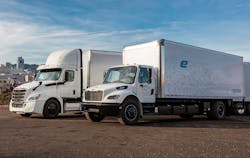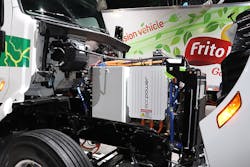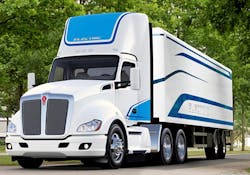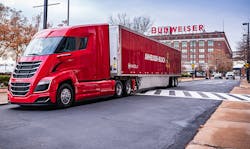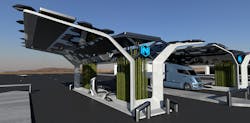"Trucking is now at the cool kids’ table,” thought Mike Roeth, executive director of the North American Council on Freight Efficiency (NACFE), after departing from the rock concert-style unveiling of the battery-electric truck called the Tesla Semi in November 2017. He had reason to be excited while exiting the Hawthorne, Calif., event.
Tesla’s CEO Elon Musk pulled onto the stage in the sleek silver prototype Class 8 tractor-trailer and dropped wild performance claims such as acceleration of 0-60 mph in 5 seconds (unloaded) and 20 seconds maxed out at an 80,000 pound gross vehicle weight rating — and more unbelievably, a 500-mile range at that max weight and 65 mph. Charging time? Merely 30 minutes for 400 miles of range.
Each spec was met with applause from his “adoring fans.” That kind of positive feeling is infectious, so it was understandable that even Roeth, a former Navistar engineering director with 35 years of industry experience, was excited.
NACFE has a mission to help fleets move in the most efficient, sustainable way, using whatever technology and techniques that will get them to their destination in the safest, most cost-effective manner. Battery electric vehicles (BEVs) check all the boxes, from advantageous fuel prices (the going rate for electric) to total cost of ownership. With no internal combustion engine, downtime and maintenance drop drastically. And they are compliant with even California’s strict emissions rules, as they don’t produce any at the tailpipe.
Fleets expressed excitement, with reservations pouring in for the battery-electric truck, which was priced at $150,000 for the 300-mile range model and $200,000 for the 500-mile one. FedEx. J.B. Hunt. Ryder. Walmart. And many more. They all signaled their confidence in Musk, who was simultaneously working on streamlining Tesla’s consumer car production, developing what would become the Tesla Cybertruck, and colonizing Mars, to name a few.
This unveiling differed greatly from the typical, relatively quiet approach conventional trucking OEMs would take to roll out new equipment. That’s not to say they weren’t working on their own innovations. Despite all the technological progress in the last decade with automation and electrification, even the trucking technologists still had a “diesel-exhaust-is-in-our-blood” mentality, Roeth explained, even as the new wave of drivers embraced new tech.
“The whole industry was way too modest,” Roeth said. “[The Tesla Semi event] lit a fuse inside the trucking industry.”
Other OEMs, which had manufactured many trucks for many decades (but no spaceships) seemed to take notice. In the months following that Tesla event, Roeth noted “a number of skunkworks electric truck programs emerged.”
This included Class 8 trucks such as the Freightliner Trucks’ eCascadia and Peterbilt Motors’ Model 579EV, both announced in spring 2018.
Cummins preceded Tesla by revealing the Class 7 concept truck called the AEOS in September 2017.
Since then, the heavy-duty sector has veered into the fast lane of electrification, with OEMs and startups alike racing to get zero-emissions trucks, which include battery-electric and hydrogen fuel cell, to fleets for testing and actual production.
While Tesla has gone from stadium rock decibels to radio silence, with its initial production start date moved from 2019 to late 2020, many of the major U.S. truck OEMs have been stringing together real use cases to prove batteries’ staying power in the heavy-duty market.
The field tests are too new to discern much in the way of specifics, but the general findings indicate there are applications ready for electrification in the next few years.
Luckily, the first place to start is close to home.
Regional haul
Roeth said NACFE’s research shows that the short-haul nature and return-to-base operation of a regional haul makes it the best route class to electrify first. This includes drayage as well as delivery. Lighter loads work better if a truck is up against the range threshold, as weight and range are linked just as weight and miles per gallon, though there are other considerations.
As an example, he cited a typical Pepsi beverage delivery application. Drivers end up going into stores for hours, and therefore have shorter routes. Then they return to base overnight, which would be a perfect time to recharge.
“Even with a heavier load, they’ve got the dwell time and the lower miles,” Roeth said. “It could be an electric truck earlier rather than later.”
PespiCo’s Frito-Lay division is currently exploring several trucks, including the elusive Tesla Semi as part of a sustainability plan to cut emissions by 20% by 2030. Pepsi ordered 100 units in 2017. Little has been revealed since the launch, save for the alleged rollout of 15 Semis at Frito-Lay’s Modesto, Calif., plant, along with charging infrastructure, a solar system, and battery storage. The testing is set to begin in 2021. Tesla did not respond for comment for this story.
Where Tesla overpromised, older OEMs are staying pragmatic. U.S. heavy-duty market leader Freightliner Trucks’ strategy is to “underpromise and overdeliver,” according to Richard Howard, DTNA senior vice president for on-highway sales and marketing. “The technology, of course, is still in its teenage years,” he told FleetOwner. “We’re trying to learn together in terms of how the trucks are actually used in applications, getting real-life feedback from real customers.”
Daimler Trucks North America (DTNA) announced the heavy-duty eCascadia and medium-duty eM2 trucks in June 2018 at its Portland, Ore., headquarters with employees and around 100 guests in attendance. The first 30 of these would comprise the Freightliner Electric Innovation Fleet and be delivered to Penske Truck Leasing and NFI the following year.
As planned, Penske received two eCascadias in August 2019 to run deliveries for a restaurant chain in California. The first-gen eCascadia, based off the best-selling Cascadia, has a 550-kWh battery to provide a general range of 250 miles and 730 peak horsepower.
“We’re extremely pleased,” said Paul Rosa, senior vice president of procurement & fleet planning at Penske, which now has 10 eCascadias and 10 eM2s, two-thirds of the innovation fleet. “The project itself and the vehicles specifically have offered everything that we had hoped to learn and understand about technology from this point through its evolution.”
That evolution is fluid, so Rosa explained Penske is “trying to get as many different variations of routes as opposed to worrying about what kind of application it’s in. If the route can handle the range, then we go with it because we want to trial as many different instances to see how the battery performs.”
Being an electric guinea pig fleet has its challenges because of the unknowns and whether the metrics being evaluated today will be the same in six months or a year as things continue to evolve.
Battery performance metrics, including kilowatt-hour data and charging time duration, are important, Rosa said. This could change depending on time of day and how many vehicles are charging at the same time.
Testing and software updates from DTNA have impacted uptime, a concern not relevant once the trucks are in full service, so that cannot be fairly evaluated yet. The expectation is that uptime will improve. There will be no time lost to replace a diesel particulate filter, and regenerative braking will increase brake life (more noticeable for interurban routes).
The new powertrain is not devoid of care, though. Charger maintenance and dealing with the thermal system that heat and cool batteries and e-drive also need to be considered.
Freightliner has accrued 100,000 miles in its electric innovation fleet as of March 2020. A Customer Experience Fleet— six eCascadias and two eM2s that will rotate among several fleets—was also created to identify and address potential hurdles to large-scale deployment of commercial battery electric vehicles.
Environment
In the next three years, NACFE’s goal is to help figure out all those TCO advantages fleets need to know prior to making their next equipment purchase, including benefits that are difficult to monetize.
“Regulations will eventually drive the sales of thousands of zero-emission vehicles,” said Mark Wagner, product planning manager for Kenworth Trucks, at the recent Work Truck Show’s Green Truck Summit. This is even with electric trucks costing two to three times higher than their diesel counterparts, he noted.
“Many fleets agree image is important,” Wagner continued. “They want zero emissions to help market and brand their operations and products. In many cases, they also feel that a green image will help attract talent into their organizations.”
To that end, Kenworth worked with Meritor to develop the T680E from the Class 8 diesel model. It will be available in early 2021 in 6x2 and 6x4 configurations and have a range of 100-150 miles. A medium-duty K270E using a Dana powertrain will be available late 2020 and will have a range of 100-200 miles.
Emissions are the driving force behind Dependable Highway Express taking part in the Volvo Trucks North America (VTNA) LIGHTS (Low Impact Green Heavy Transport Solutions) project, a $90 million electric endeavor funded by the California Air Resources Board , Volvo Group, and other groups.
“Our commitment to this project is founded in the fact that we understand our industry contributes heavily to poor air quality,” said Troy Musgrave, director of process improvement at Dependable. “And by investing in future technologies to clean up the air, there are obvious benefits that can be achieved.”
In May, the division, comprising a fleet of about 380 trucks, will receive three VNR Electric Class 8 trucks for regional pickup and delivery in California. They are expected to have a range of 75 to 175 miles.
Musgrave drove the VNR Electric at the VTNA test track in Greensboro, N.C., and views the electric day cab as not only new, efficient equipment but also as a retention tool. “It will definitely enhance our recruiting opportunities not just for drivers, but for anyone from dispatchers to administrators to salespeople who are thinking about global warming, pollution, and how new technology is available to address those things,” he said.
That’s the dream. To get there, fleets must get ahead of the potential charging infrastructure nightmare.
The infrastructure
“It’s been many months of going back and forth between the partners on the project to make sure that everything’s organized,” Musgrave said. “It’s very complicated to meet all the regulatory requirements and guidelines, too, because you have so many different partners involved, and everybody needs their criteria met.”
VTNA offers support in this area.
Though Musk said Tesla’s “megachargers” could power up a battery in 30 minutes, it’s more realistic to expect a power-up to take several hours. For the 50-kW charger, the battery accrues 25 miles of range per hour; a fast charger increases that to 75 miles of range.
Southern California Edison (SCE) is the power supplier.
“You have to plan to install the charger, probably about the same time you order the truck, or sometimes earlier than you order the truck,” explained Todd Carlson, principal manager for fleet asset management at SCE, who added incentives can defray the investment in electric vehicles.
Planning is also vital to avoid infrastructure disruptions as the fleet grows.
To avoid annual construction on new charging, Carlson recommended to install five years’, seven years’, 10 years’ worth of charging infrastructure all at once, or at least lay the conduit for that. He added that fleets need to have a capable data collection system, as power providers will ask for it “multiple times in multiple formats until they figure out what they want.” Once that’s figured out, test fleets are discovering even more questions need answers, especially when it comes to microgrids.
“What happens when the power’s not working? How are you going to support your fleet?” Musgrave asked.
Dependable relies on diesel generators for rolling brownouts. The network also has three solar fields and battery storage to generate its own renewable power. Musgrave said solar, which was once $1/kWh, has come down to $0.04/kWh. SCE currently generates 46% carbon-free energy, with a goal of 80% by 2030.
“Start the conversation now and ask as many questions as you can for guidance on the infrastructure,” Musgrave offered.
Conversely, he said fleets will be in for disappointment if they fail to plan and aren’t ready when the next wave of batteries and charging infrastructure make electric trucks not only an environmentally conscious choice, but an economic one as well.
Long haul
“You just can’t put enough battery on the truck to go more than 400 miles in a day before it’s a relatively long time to charge — even if it’s an hour or two,” Roeth said.
The Dept. of Energy projected significant improvements in storage tech, rising from 200-300 Wh/kg in 2020 to possibly 400 Wh/kg in 2030 with the next generation of lithium-ion and lithium metal with sulfur solid-state batteries. That leaves hydrogen-powered trucks, or fuel cell electric trucks (FCET) as the likely choice for long-haul operations.
Trevor Milton, CEO and founder of Nikola Motor Co. , believes the industry shouldn’t pit the technologies against each other.
“They actually don’t compete with each other; they complement each other,” said Milton, whose startup truck maker is offering both options on its lineup, the Nikola One (sleeper), Nikola Two day cab, and Nikola Tre COE for urban applications.
“Our mentality is that this world is big enough for everyone to exist. If we all come together, we have a better likelihood for success,” he said.
Milton said the Tre, which initially will be manufactured by Iveco in Europe, will have 700 kilowatt-hours on board and exceed 300 miles on a charge.
Production on the fuel-cell trucks is 24 months away; the BEV versions will be ready in 2021.
Last November, a Nikola Two completed its first zero-emission beer delivery, hauling the beer from the flagship Anheuser-Busch brewery in St. Louis to a local distributor. The brewer ordered 800 Nikola FCETs in 2018.
Nikola’s business model includes providing the hydrogen fueling stations, which were engineered by NEL Hydrogen.
“Because we can produce hydrogen at mass volume, at each station tens of thousands of kilograms per day, [hydrogen] can actually be more competitive than diesel,” Milton asserted. “As of [April 3, 2020], our cost to operate a hydrogen truck is somewhere around 20% less than a diesel truck without any government subsidies.”
Nikola wouldn’t turn down any incentives or credits, but Milton said the most useful government assistance is for “states to get out of our way” and fast track hydrogen station permits. There are two ways to get hydrogen onboard: through tankers hauling liquid state and generating compressed hydrogen on site.
At the next Nikola World event, more information was expected on new battery technology. Due to the COVID-19 pandemic, however, that event was moved from September to sometime next winter.
Until Nikola and Tesla, and even DTNA and VTNA, start full production and let fleets from Maine to San Diego push these trucks to their limits, nothing is certain until more battery electric vehicles come online and claims of performance and reliability are proven.
Having a fair amount of skepticism might be the best tool for prospective buyers. “We don’t really mind when people criticize us or wonder if it’s fake or how legitimate we are,” Milton said. “That’s a good question to have.”
And it’s one that only time and more testing will answer.
About the Author
John Hitch
Editor
John Hitch is the editor-in-chief of Fleet Maintenance, providing maintenance management and technicians with the the latest information on the tools and strategies to keep their fleets' commercial vehicles moving. He is based out of Cleveland, Ohio, and was previously senior editor for FleetOwner. He previously wrote about manufacturing and advanced technology for IndustryWeek and New Equipment Digest.
